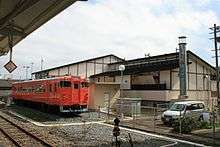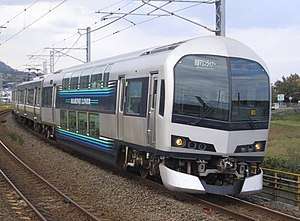KiHa 40 series
The KiHa 40 series (キハ40系, Kiha-yonjū-kei) is a diesel multiple unit (DMU) train type introduced by Japanese National Railways (JNR) in 1977 and operated by all of the Japan Railways Group companies on suburban and rural services in Japan.[2]It also served in other private railway companies in Japan since 2017 following the removal of service which have been pulled out by Japan Railways group and also served in overseas operations in Myanmar since 2011.
| KiHa 40 series KiHa 41 KiHa 47 KiHa 48 | |
|---|---|
A pair of JR Hokkaido KiHa 40 series units in January 2009 | |
| In service | 1977–present |
| Manufacturer | Fuji Heavy Industries, Niigata Tekkō |
| Replaced | KiHa 10 series, KiHa 30, KiHa 130 |
| Constructed | 1977–1983 |
| Number built | 888 vehicles |
| Number in service | 714 vehicles (as of 2018)[1] |
| Formation | Various |
| Operator(s) | JNR (1977–1987) JR Central (1987–2016) JR Hokkaido, JR East, JR-West, JR Shikoku, JR Kyushu (1987–present) Myanmar Railways (2011–present) Nishikigawa Railway (2017–present) Kominato Railway (2020–present) |
| Depot(s) | Various |
| Line(s) served | Various |
| Specifications | |
| Car body construction | Steel |
| Car length | 21,300 mm (69 ft 11 in) |
| Width | 2,900 mm (9 ft 6 in) |
| Doors | 2 per side |
| Maximum speed | 95 km/h (60 mph) |
| Multiple working | KiHa 58(San'in Main Line Only) |
| Track gauge | 1,067 mm (3 ft 6 in) |
Overview
The KiHa 40 series diesel multiple unit was introduced in 1977 by JNR to replace ageing KiHa 10 series DMUs on suburban and rural services nationwide.[3] A total of 888 vehicles were built between 1977 and 1982, broadly divided into three main types: KiHa 40, KiHa 47, and KiHa 48. These were subdivided as shown below, with further variants and modifications made later in their lives by the various JR Group companies.[1]
| Type | No. of cabs | Doors | Subclass | Region | Toilet |
|---|---|---|---|---|---|
| KiHa 40 | 2 | Single-leaf | -100 | Hokkaido (Extreme cold) | Yes |
| -500 | Cold | ||||
| -1000 | Warm | No | |||
| -2000 | Yes | ||||
| KiHa 47 | 1 | Pairs | -0 | Warm | Yes |
| -500 | Cold | ||||
| -1000 | Warm | No | |||
| -1500 | Cold | ||||
| KiHa 48 | 1 | Single-leaf | -0 | Warm | Yes |
| -300 | Hokkaido (Extreme cold) | ||||
| -500 | Cold | ||||
| -1000 | Warm | No | |||
| -1300 | Hokkaido (Extreme cold) | ||||
| -1500 | Cold |
"Cold" regions refers to the Tohoku and Chubu regions.
JNR car types
The types built for JNR were as follows.[1]
KiHa 40-100
- KiHa 40-101–250 (150 vehicles)
KiHa 40-500
- KiHa 40-501–594 (94 vehicles)
KiHa 40-1000
- KiHa 40-1001–1007 (7 vehicles)
KiHa 40-2000
- KiHa 40-2001–2148 (148 vehicles)
KiHa 47-0
- KiHa 47-1–193 (193 vehicles)
KiHa 47-500
- KiHa 47-501–522 (22 vehicles)
KiHa 47-1000
- KiHa 47-1001–1134 (134 vehicles)
KiHa 47-1500
- KiHa 47-1501–1521 (21 vehicles)
KiHa 48-0
- KiHa 48-1–6 (6 vehicles)
KiHa 48-300
- KiHa 48-301–304 (4 vehicles)
KiHa 48-500
- KiHa 48-501–559 (59 vehicles)
KiHa 48-1000
- KiHa 48-1001–1004 (4 vehicles)
KiHa 48-1300
- KiHa 48-1301–1303 (3 vehicles)
KiHa 48-1500
- KiHa 48-1501–1550 (50 vehicles)
JR Hokkaido
Following the privatization and splitting of JNR in April 1987, JR Hokkaido received a total of 157 KiHa 40 series vehicles (150 KiHa 40s and 7 KiHa 48s). As of 1 April 2010, JR Hokkaido operates 153 KiHa 40 series vehicles, classified as follows.[1]
- KiHa 40-300
- KiHa 40-330
- KiHa 40-350
- KiHa 40-400
- KiHa 40-700
- KiHa 40-1700
- KiHa 48-1300
- KiHa 400-100
- KiHa 480-300
- KiHa 480-1300
JR East
Following the privatization and splitting of JNR in April 1987, JR East received a total of 219 KiHa 40 series vehicles (117 KiHa 40s, 28 KiHa 47s, and 74 KiHa 48s). As of 1 April 2010, JR East operates 159 KiHa 40 series vehicles, classified as follows.[1] KiHa 48 502 and KiHa 48 1512 were derailed and badly damaged by the 2011 Tōhoku earthquake and tsunami on 11 March 2011, and were withdrawn.
- KiHa 40-500
- KiHa 40-1000
- KiHa 40-2000
- KiHa 47-0
- KiHa 47-500
- KiHa 47-1000
- KiHa 47-1500
- KiHa 48-500
- KiHa 48-1500
 KiHa 40 1003 in January 2011, repainted into old JNR livery
KiHa 40 1003 in January 2011, repainted into old JNR livery- KiHa 48 502 and KiHa 48 1512 after the tsunami in 2011
Joyful Train sets
- Furusato (KiHa 48-2500)
- Kirakira Michinoku (KiHa 48)
- Resort Minori (KiHa 48-500)
- Resort Shirakami "Aoike" (KiHa 48)
- Resort Shirakami "Buna" (KiHa 48)
- Resort Shirakami "Kumagera" (KiHa 48)
- Umineko (KiHa 48)
- View Coaster Kazekko (KiHa 48)
 KiHa 48 Furusato in November 2007
KiHa 48 Furusato in November 2007
JR Central
Following the privatization and splitting of JNR in April 1987, JR Central received a total of 59 KiHa 40 series vehicles (14 KiHa 40s, 5 KiHa 47s, and 40 KiHa 48s). By April 2010, JR Central operated 59 KiHa 40 series vehicles, classified as follows.[1] These were withdrawn by 2016.
- KiHa 40-3000
- KiHa 40-3300
- KiHa 40-5000
- KiHa 40-5500
- KiHa 40-5800
- KiHa 40-6000
- KiHa 40-6300
- KiHa 47-5000
- KiHa 47-6000
- KiHa 48-3500
- KiHa 48-3800
- KiHa 48-5000
- KiHa 48-5300
- KiHa 48-5500
- KiHa 48-5800
- KiHa 48-6000
- KiHa 48-6300
- KiHa 48-6500
- KiHa 48-6800
JR-West
Following the privatization and splitting of JNR in April 1987, JR-West received a total of 257 KiHa 40 series vehicles (63 KiHa 40s, 189 KiHa 47s, and 5 KiHa 48s). As of 1 April 2010, JR-West operates 255 KiHa 40 series vehicles, classified as follows.[1]
- KiHa 40-3000
- KiHa 41-2000
- KiHa 47-2000
- KiHa 47-2500
- KiHa 48-3000
- KiHa 48-3500
Joyful Train sets
- Misuzu Shiosai (KiHa 47)
- Setonai Marine View (KiHa 47)
- Belles Montagnes el Mer (KiHa 40)
- Hanayome Noren (KiHa 48)
- Tenkū no shiro Takeda-jō ato (KiHa 40)
JR Shikoku
Following the privatization and splitting of JNR in April 1987, JR Shikoku received a total of 53 KiHa 40 series vehicles (11 KiHa 40s and 42 KiHa 47s). As of 1 April 2010, JR Shikoku operates 43 KiHa 40 series vehicles, classified as follows.[1]
- KiHa 40-2000
- KiHa 47-0
- KiHa 47-500
- KiHa 47-1000
- KiHa 47-1500
Joyful Train sets
- Iyonada Monogatari (KiHa 47)
JR Kyushu
Following the privatization and splitting of JNR in April 1987, JR Kyushu received a total of 142 KiHa 40 series vehicles (36 KiHa 40s and 106 KiHa 47s). As of 1 April 2010, JR Kyushu operates 140 KiHa 40 series vehicles, classified as follows.[1]
- KiHa 40-7000
- KiHa 40-8000
- KiHa 47-3500
- KiHa 47-4500
- KiHa 47-5000
- KiHa 47-6000
- KiHa 47-8000
- KiHa 47-8500
- KiHa 47-9000
- KiHa 47-9500
- KiHa 140-2000
- KiHa 147-0
- KiHa 147-1000
Joyful Train sets
- Hayato no Kaze (KiHa 47/147)
- Ibusuki no Tamatebako (KiHa 47/140)
- Aru Ressha (KiRoShi 47)
 Hayato no Kaze in July 2009
Hayato no Kaze in July 2009 Ibusuki no Tamatebako in February 2011
Ibusuki no Tamatebako in February 2011 Aru Ressha in October 2015
Aru Ressha in October 2015
Resale
Nishikigawa Railway
In 2017, 1 KiHa 40-1009 diesel carriage was taken over by Nishikigawa Railway, that ended operation on the Karasuyama Line by JR East in March 2017, the former diesel train is remodeled in retro style, and started operation on September 16 of the same year. [4]
 Former JR East KiHa 40 series DMU car KiHa 40-1009 at Nishikichō Station on the Nishikigawa Railway in Yamaguchi Prefecture, Japan.
Former JR East KiHa 40 series DMU car KiHa 40-1009 at Nishikichō Station on the Nishikigawa Railway in Yamaguchi Prefecture, Japan.
Kominato Railway
2 KiHa 40 carriages (KiHa 40-2021 and KiHa 40-2026), which ended operation on the Tadami Line in March 2020, were transferred in May 2020 with the Tohoku livery. [5][6]
 A photo of the former JR East KiHa 40 is scheduled to be transferred to Kominato Railway is detained at Soga Station.
A photo of the former JR East KiHa 40 is scheduled to be transferred to Kominato Railway is detained at Soga Station.
Overseas operations

A large fleet of former KiHa 40 series cars from JR East, JR Hokkaido, JR Shikoku, and JR Central were shipped to Myanmar between 2011 and 2016. A total of 48 diesel cars (including KiHa 40, KiHa 47, & KiHa 48) have been shipped to Myanmar for overseas operations.[7] The cars are used on the Yangon Circular Railway.
Preserved examples
- KiHa 40 519: Next to Onagawa Station, Onagawa, Miyagi.[1] However, it was damaged by the 2011 Tōhoku earthquake and tsunami on 11 March 2011, and was withdrawn.
- KiHa 40 764: Next to Ikutora Station, Minamifurano, Hokkaido as a cutaway body. This DMU was modified to resemble a KiHa 12 unit and used in Yasuo Furuhata's 1999 film Poppoya (鉄道員, Poppoya / Tetsudōin, "Railwayman").[8]
 Preserved KiHa 40 519 next to Onagawa Station in September 2007
Preserved KiHa 40 519 next to Onagawa Station in September 2007 KiHa 40 764 in August 2011
KiHa 40 764 in August 2011
In popular culture
- The KiHa 140 is featured as a non-driveable train in the Microsoft Train Simulator computer game.
- In 2017 NHK World-Japan dedicated a whole episode of their weekly show Japan Railway Journal to the KiHa 40 series.[9]
References
- Nishiwaki, Kōji; Fujita, Gorō (January 2011). キハ40系一族 [The KiHa 40 Series Family]. Japan Railfan Magazine. Vol. 51 no. 597. Japan: Koyusha Co., Ltd. pp. 15–63.
- Haraguchi, Takayuki (2009). Encyclopedia of JR's Railway Cars: JR全車輌. Japan: Sekai Bunka. pp. 126–127. ISBN 978-4-418-09905-4.
- Jēāru zensharyō handobukku: Rail Magazine 2009 JR全車輌ハンドブック2009 [JR Rolling Stock Handbook 2009]. Japan: Neko Publishing. 2009. pp. 461–470. ISBN 978-4-7770-0836-0.
- Toshihiko, Ninomiya. "山口)「キハ40形」錦川鉄道に到着 9月以降に運行". www.asahi.com (in jp). Retrieved 24 May 2020.CS1 maint: unrecognized language (link)
- "鉄道ダイヤ情". www.kotsu.co.jp (in jp). Retrieved 24 May 2020.CS1 maint: unrecognized language (link)
- "小湊鉄道 レア車両搬入で撮り鉄"密状態"に困惑「気持ちは分かるが、こんな時期なんで」". www.sponichi.co.jp (in jp). Retrieved 24 May 2020.CS1 maint: unrecognized language (link)
- Diesel Railcars from Japan
- "キハ40 764" [KiHa 40 764]. rail.hobidas.com. Neko Publishing. 22 April 2014. Retrieved 11 July 2019.
- "Japan Railway Journal Episode 35 - The Unsung Hero of Japanese Railways: Series Kiha 40 Diesel Trains, Originally Aired Friday, June 16, 2017". Retrieved 26 September 2019.
Further reading
- Ishii, Yoshitaka (27 February 2009). キハ47物語: ローカル線の主役一般形キハの歩み キハ47物語 [The KiHa 47 story]. Japan: JTB Can Books. ISBN 978-4533074271.
External links
| Wikimedia Commons has media related to KiHa 40 series. |
- JR Central KiHa 40/47/48 information (in Japanese)


